Source Institutions
Source Institutions
Add to list Go to activity
Activity link broken? See if it's at the internet archive

In this outdoor, sunny day activity, learners experiment with paper leaf models to discover how some desert plants conserve water. Learners explore adaptations of various desert plants such as waxy coatings, thick stems, and spines and fine hairs to see which characteristics best help a plant hold water. Learners compare their model leaves to real desert leaves if they are available. Even in a nondesert region, the activity can be done at a local botanical garden that may include a desert plant collection or in any hot, dry area.
- 45 to 60 minutes
- 45 to 60 minutes
- $10 - $20 per group of students
- Ages 8 - 18
- Activity, Experiment/Lab Activity, Field Trip, Lesson/Lesson Plan, Model, Simulation
- English
Quick Guide
Materials List (per group of students)
- plastic coffee stirrers (double-straw type)
- plstic bags
- 40-cm pieces of string
- piece of flagging
- 1 cup of water (200 ml) colored with red, green, or blue food coloring
- 1 small bucket or basin of water
- several medicine droppers
- several crayons
- masking or transparent tape
- stapler
- extra plastic bags and string
- data boad
- marking pen
- metric ruler
- large comb (optional)
- Desert Leaf Models Technique Card (page 5 of PDF)
- Desert Leaf Patterns card (page 6 of PDF)
- blotter paper sheets
- scissors
- plastic drinking straws
- balls of clay
- tape
Subjects
-
Life Sciences
-
Diversity of Life
- Plants
-
Ecology
- Ecosystems
-
Evolution
- Evidence for Evolution
-
Diversity of Life
-
The Nature of Science
-
The Scientific Process
- Asking Questions
- Conducting Investigations
- Gathering Data
- Formulating Explanations
- Communicating Results
-
The Scientific Process
Informal Categories
- Gardening
- Nature and Environment
- Outdoor Activity
- Physical Activity
Audience
To use this activity, learners need to:
- see
- see color
- read
- be mobile
- touch
Learning styles supported:
- Involves teamwork and communication skills
- Involves hands-on or lab activities
Other
This resource is part of:
Access Rights:
- Free access
By:
Rights:
- All rights reserved, The Regents of the University of California, 1980
